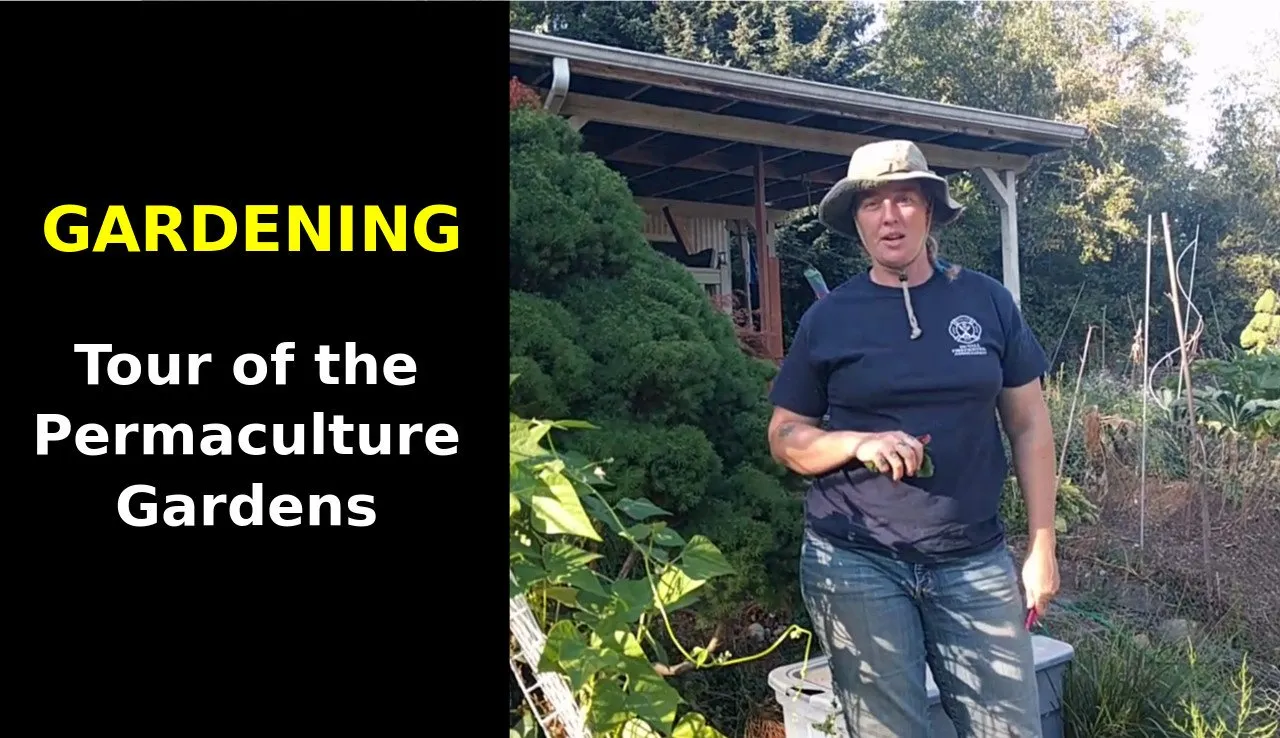
Liz Crain gives a tour of the Permaculture Gardens on Leafhopper Farm. She details out the plants currently growing in the garden including corn, kale, hops, peas and many more! She also discusses how she uses Roosters and Goldfish to enrich the system.
If DTube is being slow, you can also Watch on YouTube.
Curly Leaf Kale
- This breed of Kale is hearty and able to survive through Fall and sometimes through the Winter. It is great for casual walk-by snacking but is also good for steeming or cooking in stir fries.
Swiss Chard
- Chard is a leafy green that is good fresh or steamed and goes very well alongside Kale.
Flamingo Chard
- Flamingo Chard has beautiful vibrant pink stems that add a lot of color to the garden. They continually produce food into the late Fall.
Cascadian Hops
- Hops are probably most known for their use in the brewing of beer and other drinks. They are also used as a medicinal plant that can be smoked or made into tinctures. It has a mild sedative effect and can help with anxiety and sleeplessness. They trail and climb on posts and branches, and are very prolific. Be careful or they can take over your garden.
Hopi Black Corn
- Plant them in groupings so that they can pollinate each other. Without pollination they will not produce any corn.
Borage
- Borage attracts bees to the garden so is very useful for ensuring your other plants are getting pollintated. They produce little blue flower which are edible but can be tedious to harvest in bulk. They are also great conditioners for the soil.
Peas
- To plant peas for next year, break off the dry pods and split them open. Place the seeds in the dirt and water the area thoroughly to give them a good start. Using a cloche can result in pea harvests in the Winter!
Mullein
- Many people consider Mullein to be a weed, but it can be smoked medicinally to clean the lungs. It shoots up a big seed stock which can be used to spread more of it on your land, and the stalk can later be used as a torch.
Snowball Viburnum
- This is a very aggressive plant, but provides good mulch due to the amount of biomass it produces. It has strong roots and is excellent when used in a hedgerow fence.
Black Currant
- Black Currant grows very well at the base of Viburnum because it can use it as a trellis to grow up on. It's fruit are edible.
Radish
- At a certain point Radish will bolt and go to seed at which point they are less palatable, taking on a woody texture. When this has happened it's best to collect the seed for next year's garden.
Asparagus
- Asparagus is very dear to Liz's heart because her grandfather grew it in the South. It's hard to get it started, but once you have it is very prolific. This is their second year on the farm and they're just now showing signs of being well established. They require a lot of compost, so it can be a good idea to keep compost bins nearby.
Other Plants in the Garden
- Snapdragon, Tomatillo, Dill, Fennel, Peas, Potatoes, Beans, Roses, Squash, Kitchen Sage, Tomato & Lettuce.
The Cloche
- A Cloche or a Hoop House is a covered area in a garden which grants plants a higher likelhihood of being able to survive the cooler temperatures of Fall and Winter.
Rain Barrels
- These barrels catch rain water during the wetter months which can be used to hydrate the garden during the Summer. Plant cuttings can be placed in the water to help them establish enough roots to be planted. We place goldfish in the barrel which eat algae and poop nutrients which help the garden. In the Fall the fish are moved to the Pond and new goldfish are introduced to the barrels in the Spring.
Chickens & Roosters
- Chickens and Roosters can be used to till up the soil and eat the bugs and larvae living there. They also clean the garden of insect eggs and weed seeds.
Flipping Beds
- We dump dirt or mulch into the bottom of the garden to introduce new biomass. Occasionally this is turned over and moved uphill onto a bed of branches creating a new bed for the next year. This is continued until the material reaches the top of the garden.
Composting Bins
- Having your composting bins right in the garden is useful because they drain nutrients into the soil. This is done by drilling holes in the bottom, which also allows worms to come and go as they please to assist with the composting.
Thanks for stopping by and have a wonderful day!
WEBSITE: leafhopperfarm.com
TWITTER: twitter.com/LeafhopperFarm
MINDS: minds.com/leafhopperfarm
YOUTUBE: 
► Watch on DTube
► Watch Source (IPFS)
